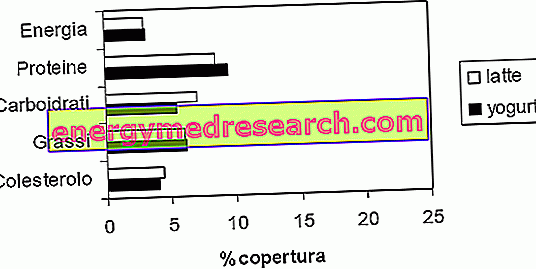What is citric acid?
Citric acid is an organic acidic compound, more precisely a weak tricarboxylic acid, with the formula C 6 H 8 O 7 . At room temperature it appears as a white crystalline powder, it is harmless and is commonly found in foods, especially in citrus fruits.

Citric acid is also a product of great industrial use, especially as a food additive (abbreviation E330).
What is citrate?
Citrate is a derivative of citric acid; in particular, it can represent the salt, ester or polyatomic anion that is in solution.
An example of salt is trisodium citrate, while an example of ester is triethyl citrate.
Where is it
What are the natural sources of citric acid?
Citric acid is widespread
- In the vegetable kingdom, especially in citrus fruits (but not only). In these products, the concentrations of citric acid range from 0.005 mol / l for oranges and grapefruits, up to 0.30 mol / l for lemons and limes; these values can change depending on the cultivar and the circumstances in which the fruit was obtained.
Lemons are particularly rich and contain up to 8% by weight on the dry substance; this means that citric acid is present up to 47 g per liter of lemon juice.
- In animal tissues, where it participates in the Krebs cycle (an important metabolic pathway dedicated to the production of aerobic energy).
Purposes
What is citric acid for?
Once produced on an industrial level, citric acid is widely used as:
- Acidity regulator: acidifier
- Flavoring
- Flavor enhancer: it has a sour taste that strengthens the salty and bitter taste, but does not add particular flavors to the food
- Chelating agent
- Preservative (E330): antioxidant; its presence in fruit, associated with the natural presence of vitamin C (ascorbic acid), delays the oxidation of the pulp, preventing browning. Citric acid is used as a preserving agent also in the preparation of pharmaceutical products, such as powders and effervescent tablets.
The food products that are most frequently enriched with citric acid are: drinks, jams and other fruit and vegetable preserves.
Due to its strong antioxidant function, it is often added to preserved meats. In the food product label we can also find it with the abbreviation E330 .
More than half of the industrial production of citric acid is used as an acidity regulator in beverages, about 20% in other food applications, 20% for detergent production and 10% for similar applications, for example cosmetics, pharmaceuticals and chemical industry.
See also: citric acid in cosmetics
See also: recipes with citric acid
Nutrition
Is citric acid a nutrient?
More than a nutrient, citric acid is considered a nutritional factor. It is not essential, since the organism is able to produce it autonomously, but still plays a very important role for biological functions.
Its main functions are:
- Together with vitamin C (ascorbic acid) it favors the absorption of iron.
- It prevents the formation of kidney stones from cystine, xanthines and uric acid.
- It is an excellent urinary alkalinizing and can be used
- to enhance the therapeutic activity of drugs or supplements that require basic urine to best perform their therapeutic action,
- to favor the excretion of drugs with weak acid characteristics.
- It also performs a mild bactericidal and anti-arthritic action.
Excess
Does too much citric acid hurt?
Excessive consumption of citric acid can damage enamel and facilitate dental erosion; for this reason, dentists recommend waiting a few minutes before brushing your teeth after drinking acidic drinks.
Furthermore, the excess of citric acid at pharmacological doses can lead to systemic alkalosis, with an increase in blood pH above physiological values; although it is not a particularly dangerous condition, on a muscular level it can cause weakness, pain and cramps up to the tetany.
As for the salts of citric acid, the risks of overdosing depend on the mineral to which citric acid is bound; for example, in the case of potassium citrate the risk of overdose is hyperkalemia.
Drug interactions *
- Amphetamines, ephedrine, pseudoefredina or quinidine: the simultaneous intake of citric acid can prolong the duration of action of these drugs, reducing their urinary elimination;
- Antacids, especially those containing bicarbonates: the simultaneous intake of citric acid can result in systemic alkalosis; for antacids based on aluminum salts, the simultaneous intake of citric acid can increase the absorption and consequent toxicity of aluminum, especially in patients with renal insufficiency;
- Anticholinergics: the simultaneous intake of citric acid can increase the risk of gastric irritation, due to a slowing down of the stomach.
- ACE inhibitors, NSAIDs, cyclosporins, potassium-sparing diuretics, heparin, potassium-based medicines, digitalis and salt substitutes: the simultaneous intake of potassium citrate can increase plasma mineral levels, causing even severe hyperkalemia (up to arrest cardiac, especially in case of renal insufficiency)
- Ciprofloxacin, norfloxacin, ofloxacin: the simultaneous intake of citric acid can reduce the solubility of these drugs in the urine, increasing the risk of crystalluria and nephrotoxicity.
- Laxatives: the simultaneous intake of citrates can increase the laxative effect;
- Lithium, Salicylates, Methenamine: the simultaneous intake of citric acid can reduce its duration of action and its therapeutic effect, increasing its urinary elimination;
- Sodium-based drugs: simultaneous intake of sodium citrate may increase the risk of hypernatremia.
Industrial Extraction
How can citric acid be obtained?
More than one million tons of citric acid is synthesized every year. However, the contemporary production method is very different from the initial one.
The industrial production of citric acid began in Italy in 1890 with the extraction from citrus fruits (in particular from the lemon which contains 5-8%); the lemon juice was then treated with calcium hydroxide to precipitate calcium citrate, to be isolated and converted back to acid using diluted sulfuric acid.
In 1893, C. Wehmer discovered that Penicillium mold is able to produce citric acid from sugar. After fermentation, the mold is filtered by the resulting solution and the citric acid is isolated causing it to precipitate and regenerate it as in the first system. However, this system did not become industrial until the interruption of the Italian citrus fruit trade, which occurred during the First World War, a period in which it became a necessity.
In 1917 the American chemist James Currie discovered an even more efficient mold, Aspergillus niger, which was then used by the pharmaceutical company "Pfizer".
In 1977 Lever Brothers patented the chemical synthesis of citric acid from the calcium aconitic or isocitrate / alloisocitrate salts under high pressure conditions.
Considering its wide use, citric acid is today produced mainly with these last two systems, in which A. niger is allowed to ferment inexpensive sugar solutions such as corn syrup, molasses, hydrolyzed corn starch etc. to get calcium salts then converted to high pressure.
In 2007 the annual world production of citric acid reached about 1, 600, 000 tons, of which more than 50% came from China.



